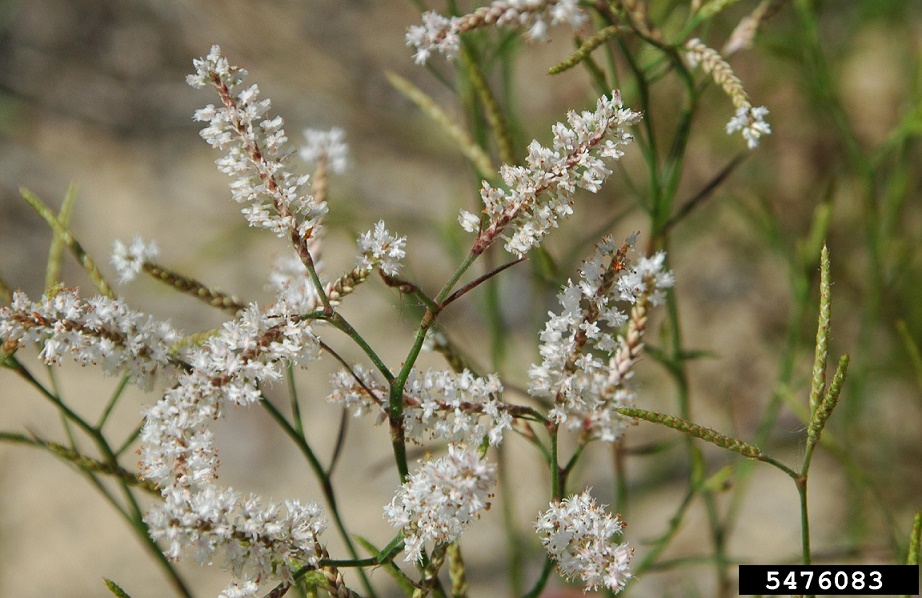Polygonella polygama
| Polygonella polygama | |
|---|---|

| |
| Photo by Karan A. Rawlins, University of Georgia, Bugwood.org | |
| Scientific classification | |
| Kingdom: | Plantae |
| Division: | Magnoliophyta - Flowering plants |
| Class: | Magnoliopsida – Dicotyledons |
| Order: | Caryophyllales |
| Family: | Polygonaceae |
| Genus: | Polygonella |
| Species: | P. polygama |
| Binomial name | |
| Polygonella polygama (Vent.) Engelm. & A. Gray | |

| |
| Natural range of Polygonella polygama from USDA NRCS Plants Database. | |
Common name: October flower
Contents
Taxonomic notes
Synonym: Polygonella polygama There are three geographically distinct varieties: var. brachystachya is only found in southern and south-central Florida and appears to be the most unique of the three varieties; var. cromii occurs primarily in North and South Carolina; var. polygama is widely distributed and appears to be sympatric with var. croomii[1].
Description
A description of Polygonella polygama is provided in The Flora of North America.
Distribution
P. polygama is distributed throughout the Coastal Plain, from southeast Virginia to south-central Florida, west to Texas[2]. Polygonella polygama var. polygama is endemic to the longleaf pine range from southeastern Virgnia to central Florida and west to southeast Texas.[3]
Ecology
Habitat
In the Coastal Plain in Florida, P. polygama can occur in seasonally wet depressions with Hypericum tenuifolium and Paronychia chartacea; and in xeric oak/saw palmetto scrubs. In disturbed areas it can be found in roadside ditches, clear-cut slash pine forests,wooded beach dunes; and dry sandy spoil material that has been pumped from the river during dredging operations[4][5]. Associated species include Liatris laevigata, Hypericum tenuifolim, Paronychia chartacea and Palafoxia integrifolia. Soil types include white sand and loamy sand[4].
Phenology
Flowers in September and October[4] seed mature in winter[6].
Seed dispersal
This species is thought to be dispersed by gravity. [7]
Seed bank and germination
Physical dormancy does not typically occur, however, some seeds possess a non-deep physiological dormancy[8].
Pollination
The following Hymenoptera families and species were observed visiting flowers of Polygonella polygama at Archbold Biological Station (Deyrup 2015):
Colletidae: Colletes mandibularis
Halictidae: Augochlorella aurata, Augochloropsis anonyma, A. metallica, Halictus poeyi, Lasioglossum nymphalis, L. placidensis, Sphecodes heraclei
Leucospididae: Leucospis slossonae
Pompilidae: Anoplius marginalis, Episyron conterminus posterus
Sphecidae: Gorytes deceptor, Oxybelus decorosum, Tachytes distinctus, T. validus
Vespidae: Eumenes smithii, Leptochilus republicanus, Pachodynerus erynnis
Photo Gallery
Flowers of Polygonella polygama Photo by Karan A. Rawlins, University of Georgia, Bugwood.org
References and notes
Deyrup, M.A. and N.D. 2015. Database of observations of Hymenoptera visitations to flowers of plants on Archbold Biological Station, Florida, USA.
- ↑ Nesom, G. L. and V. M. Bates (1984). "Reevaluations of Infraspecific Taxonomy in Polygonella (Polygonaceae)." Brittonia 36(1): 37-44
- ↑ [[1]] Encyclopedia of Life. Accessed: February 22, 2016
- ↑ Sorrie, B. A. and A. S. Weakley 2001. Coastal Plain valcular plant endemics: Phytogeographic patterns. Castanea 66: 50-82.
- ↑ 4.0 4.1 4.2 Florida State University Robert K. Godfrey Herbarium database. URL: http://herbarium.bio.fsu.edu. Last accessed: October 2015. Collectors: Loran Anderson, Wilson Baker, Angus Ghloson Jr., Robert K. Godfrey, Ann Johnson, Robert L. Lazor, Cecil R. Slaughter. States and Counties: Florida: Bay, Franklin, Holmes, Osceola. Compiled by Tall Timbers Research Station and Land Conservancy.
- ↑ Looney, P. B. and D. J. Gibson (1995). "The Relationship between the Soil Seed Bank and Above-Ground Vegetation of a Coastal Barrier Island." Journal of Vegetation Science 6(6): 825-836
- ↑ [[2]]Accessed: February 22, 2016
- ↑ Kirkman, L. Katherine. Unpublished database of seed dispersal mode of plants found in Coastal Plain longleaf pine-grasslands of the Jones Ecological Research Center, Georgia.
- ↑ Heather, A. E., H. E. Perez, et al. (2010). "Non-deep physiological dormancy in seeds of two Polygonella species with horticultural potential." HortScience 45(12): 1854-1858
